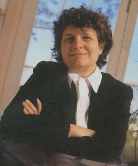| |

|
|
|
|
Big Talk in Healthcare -- Voice Recognition
|
Voice recognition technology has sold in healthcare markets for years,
usually as stand-alone systems for individual users. But two changes that
occurred in the past year have made voice recognition far more attractive
to customers and integrators alike. First and foremost is the introduction
of continuous speech products by all of the major speech vendors, including
Dragon Systems, IBM, and Lernout & Hauspie This
innovation is directly related to improvements in recognition speed and
accuracy.
"Continuous speech systems can record 100 to 130 words a minute, with
accuracy in the 98 percent range. I find that voice recognition
systems provide results that are at least as good as most transcription
services," says Steve Scheer, VP of marketing for Global Digital Information
in Bellevue, WA. Global Digital publishes CaduSys Medical Record
software for Windows NT.
The other big change is the introduction of software development kits
by the major vendors. These kits provide integrators and ISVs with shortcuts
that make incorporating voice recognition into existing applications easier
than before.
|
|
 |
| "Voice recognition eliminates delays in creating patient
records." Rachelle Reisenberg, President of AM Technologies a Newton, MA-based
integrator that focuses on speech recognition. |
"Doing so is well worth the effort," says Scheer. His company recently integrated
Newton, MA-based Dragon Systems' NaturallySpeaking product with CaduSys. "We
estimate that adding voice can save clinics $1,000 per month, per provider,
in transcription costs," he says. "That savings by itself cost-justifies our entire
medical records system. And doctors love it because they can treat the same
number of patients each day and then go home at a decent hour."
Customer Education Still Required
Because it is new and unfamiliar to many customers, voice recognition is a
technology area where integrators can make a big impact, according to Rachelle
Reisenberg, president of AM Technologies, a Newton, MA-based integrator
that focuses on speech recognition.
"If you saw a demo just a year ago, the capabilities will amaze you," she says.
"One of the challenges of selling the technology is managing customer
expectations about the technology's capabilities, which are equally likely to be
too high or too low."
"Customers have to be trained to understand what kinds of mistakes voice
recognition makes and how to make corrections," Reisberg says. The other side of
the equation is that they may not be aware of of its capabilities.
Reisberg's firm has benefited from the recent surge in customer interest.
Last year most of the firm's voice recognition sales involved only one or two
product units Recently the integrator has been asked to bid on solutions scaled
to midsize practices and emergency rooms that require support for a dozen users,
as well as larger organizations that want to run pilots before scaling to a
departmental buy.
The shrink-wrapped $50 voice recognition products sold by mass marketers are
usually inappropriate for professional installations. It is for that reason that
all of the major players encourage their channel partners to sell the high-end
versions of their products, which can be customized for particular audiences.
Some products are tweaked by manufacturers before they're shipped to provide the
best possible performance for particular vertical markets.
These highly customized products are targeted at vertical markets where users
have a large amount of dictation to do and use a limited vocabulary. They
provide the biggest return on investment for customers and deliver the
biggest profits to integrators.
For example, IBM's MedSpeak/Radiology which boasts a 98-percent accuracy
rate, is building a loyal following. Integrators that want to develop their own
vertical-market packages can also build on products like Dragon's
NaturallySpeaking Medical Suite, which includes a copy of Dragon's high-end
engine, a customizable medical dictionary, and a suite of customized medical
templates and applications from Corel.
The payoff with voice recognition has been impressive for many healthcare
providers. "Voice recognition improved my job dramatically," says Stacey Wanless,
an administrative assistant for an Alma, MI, orthopedic surgeon's office, who
uses Dragon's NaturallySpeaking. "I no longer transcribe. It used to take 8 to 10
hours to transcribe 20 charts a day. Now it takes 2.5 hours, and most of my time
is spent getting money back into the practice."
Joe Devlin and Emily Berk are partners in Armadillo Associates Inc., a
solutions integrator with offices in Half Moon Bay, CA.
|



